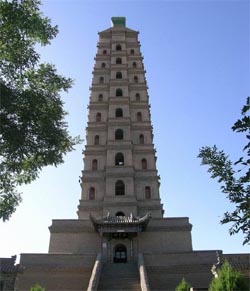 The pagoda standing for hundreds of years in the north of Yinchuan City, is regarded as Yinchuan's symbol. The pagoda standing for hundreds of years in the north of Yinchuan City, is regarded as Yinchuan's symbol.
The pagoda, located in the north of Yinchuan City, is also known as the North Pagoda and is regarded as Yinchuan's symbol. Also known as the North Pagoda, Haibao Pagoda is located on the northern outskirts of Yinchuan.
At the foot of the pagoda there is an ancient Buddhist temple, where the Ningxia Society of Buddhism is located. The Haibao Temple is sequestered in the shadow of luxuriant trees, with its pavilions, terraces and halls arranged with a picturesque taste. Since ancient times, the temple has been the sight of an annual temple fair which falls on the 15th of the seventh lunar month.
The pagoda was originally called the Black Pagoda. Nothing is known about its construction time, though legend has it that the pagoda was rebuilt by the king of the Daxia Kingdom during China's Northern and Southern Dynasties, but it was surely rebuilt during the reign of Emperor Qianlong in the Qing Dynasty.
Haibo is a brick pagoda modeled on multistoreyed counterparts. The existing pagoda has nine storeys, eleven storeys if the base and pedestal are included, and is 53.9 meters high.
The pagoda is built on a square brick base, each side measuring 19.7 meters long and 5.7 meters high. Its ground plan is cress-shaped, which is rare in multistoreyed pagodas. The first storey has a portico and an arched door. Inside is an arhat niche flanked by brick steps leading to the top of the pagoda. Arched doors on the front of each storey are flanked by false niches. Above the arched doors and niches are three tiers of chevron friezes. From the second storey up, there are three strips of molding on all sides to serve as a base for the arched doors and false niches. The interior of the pagoda is also cross-shaped and in the center of each floor is a square chamber. The pagoda tapers by fifteen to twenty centimeters from one storey to the next.
The steeple of Haibao Pagoda is different from that of other pagodas. It is peach-shaped and built of green glazed bricks. The only other pagoda with such a steeple is the one in Chengtian Temple in Yinchuan.
The top floor provides what has been known since the Ming and Qing dynasties as one of Ningxia's eight major sceneries -- a panoramic view of Yinchuan, whose landscape is suggestive of the scenery south of the Yangtze River.
|
